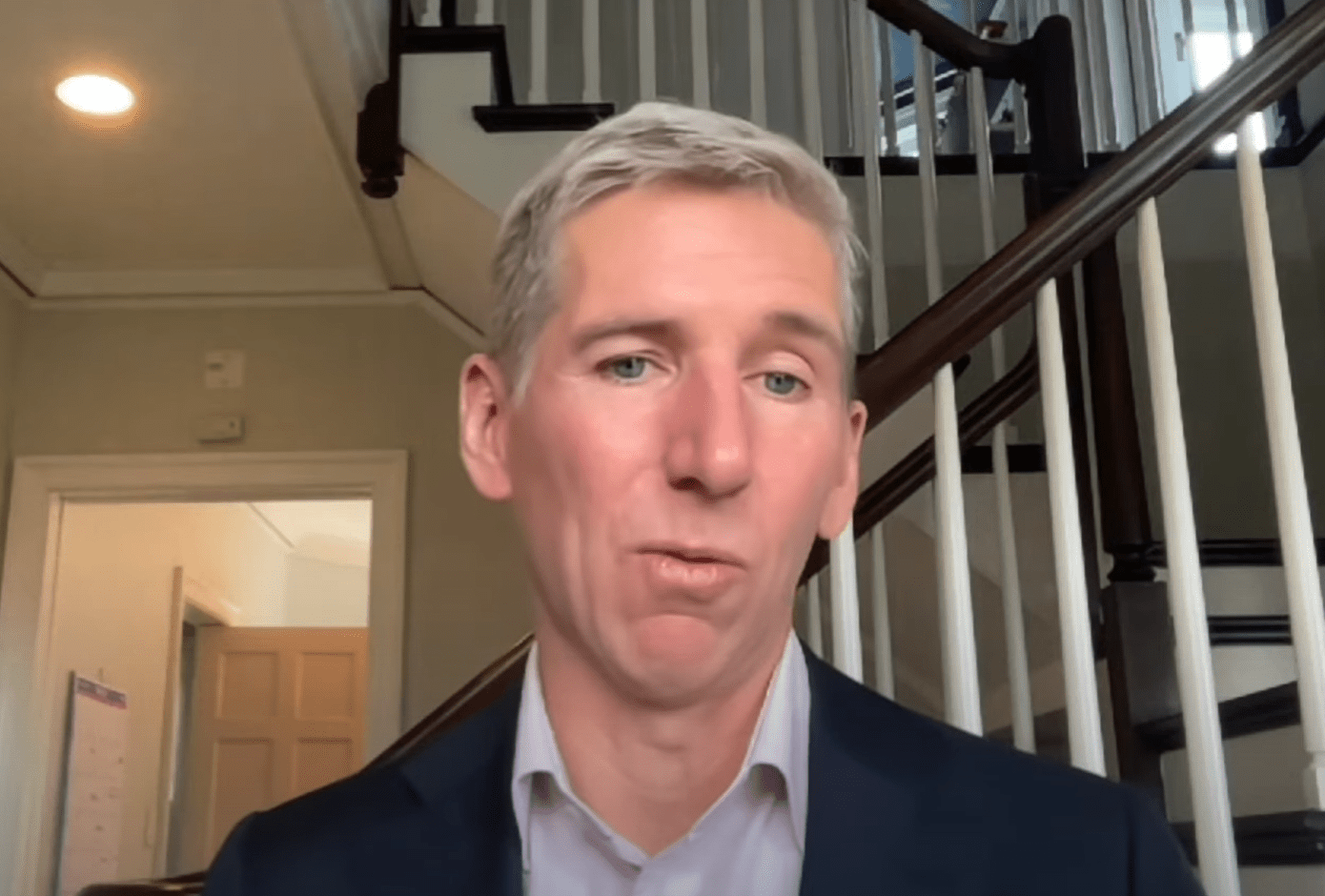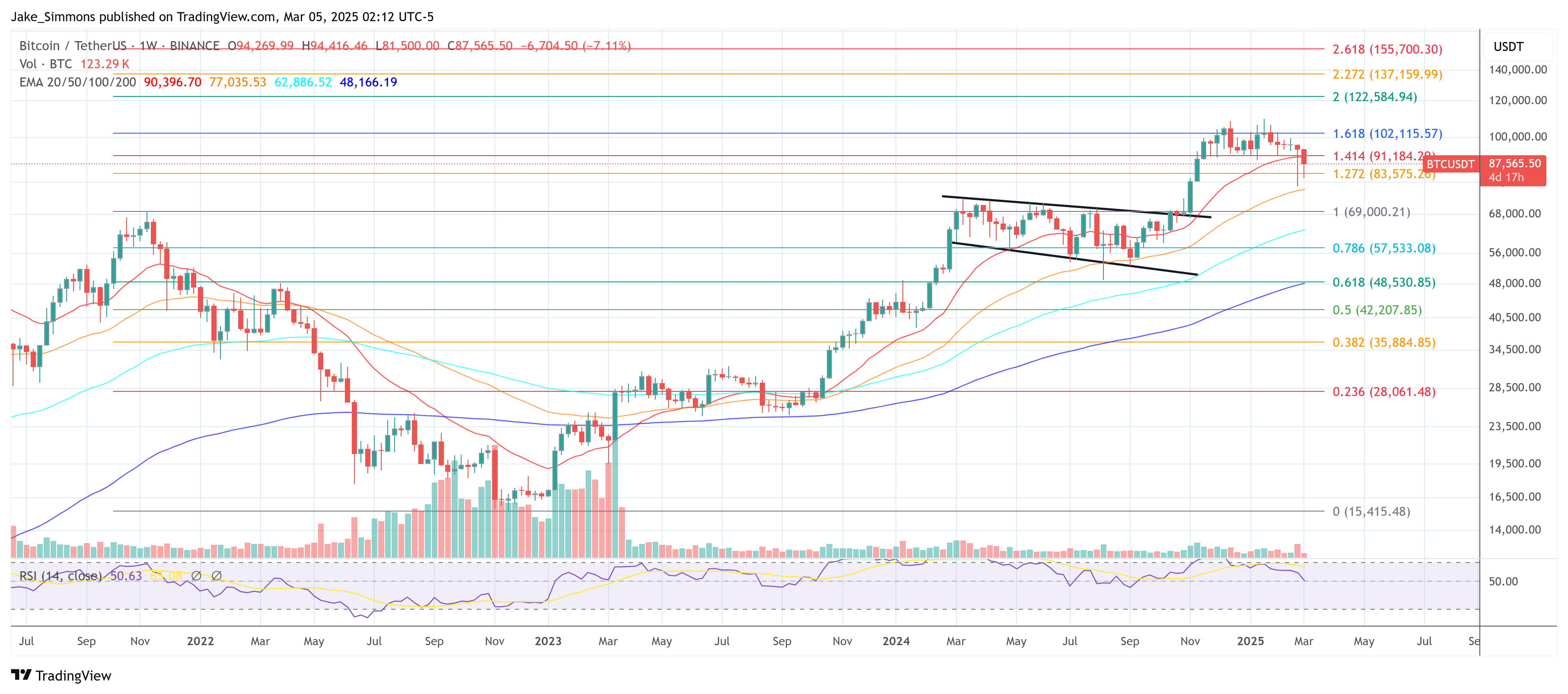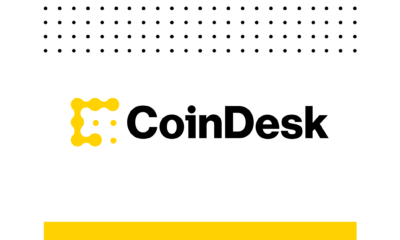Bitcoin
Crypto Markets Are Misreading Trump’s Strategic Reserve: Bitwise
Published
2 months agoon
By
admin
The crypto markets have whipsawed following President Donald Trump’s unexpected announcement of a strategic crypto reserve over the weekend. Bitwise Asset Management’s Chief Investment Officer (CIO), Matt Hougan, contends that traders are overreacting to the proposed plan’s details and missing what could be a bullish development for digital assets.
Late Sunday, President Trump revealed a United States government initiative to acquire and hold five different cryptocurrencies—Bitcoin, Ethereum, Solana, XRP, and Cardano—in a strategic reserve. Initially, the market response was emphatically positive: Bitcoin’s price surged from around $85,000 to $95,000. However, as Hougan notes in his latest investor memo, that initial optimism was short-lived. By Monday, the major crypto assets named in the announcement had surrendered their gains.
Everyone Is Misjudging Trump’s Crypto Reserve
Bitwise released its memo on March 4, titled “The Market Has This Wrong: Thoughts on Trump’s Strategic Crypto Reserve.” In it, Hougan points to overly narrow market interpretations as the principal cause behind the abrupt retracement. “The market is overthinking things. For all the flaws in the rollout, the reserve news is bullish.”
Related Reading
He elaborates on why the proposal is not being greeted with lasting enthusiasm. A large part of the skepticism centers on the White House’s choice of five cryptocurrencies, which critics describe as an overly broad selection. In Hougan’s words: “The inclusion of speculative assets like Cardano feels more calculating than strategic.”
Although the plan initially seemed like a vote of confidence from Washington, some crypto commentators—such as Coinbase CEO Brian Armstrong and Castle Island Ventures Founder Nic Carter—have questioned the rationale behind broadening the reserve beyond Bitcoin. Bitwise CEO Hunter Horsley also weighed in shortly after the announcement, publicly expressing a preference for a more conservative, bitcoin-centric reserve.
Despite this, Hougan’s memo argues that market participants may be failing to see the bigger picture. In the memo, Hougan outlines three major takeaways regarding the strategic reserve plan.
Hougan suggests that President Trump’s first public draft often differs considerably from what eventually becomes policy. The reserve, he argues, might ultimately shift to a “bitcoin-only” approach or evolve to a more balanced composition following industry input. “Over the coming days, big names from the crypto industry will make their feelings felt about the reserve idea.”
According to Hougan, the announcement further cements the perception of Bitcoin as a strategically important asset. He believes this could spur competing nations to follow suit, mirroring smaller-scale adoption already seen in El Salvador, Bhutan, and Abu Dhabi. “If you are Honduras, Mexico, or Guatemala, and you’re watching El Salvador and now the US acquire bitcoin, can you really afford to be at zero?”
Related Reading
Hougan also points to the political calculus, suggesting that even a future administration with different views might not divest the reserve once it exists. He notes that the US has historically held onto strategic assets, such as gold, for extended periods. “We learned this in the last election, where the GOP’s courtship of crypto gained it many votes while Democratic hostility gained few. I suspect that any crypto that is purchased will be held for a very long time.”
Despite the optimism, Hougan acknowledges the prospect that the pushback could become so intense that the reserve is either scaled down or scrapped. Critics say that including less-established assets alongside Bitcoin only muddies the waters and may undermine the legitimacy of the initiative. Hougan, however, believes that “the final reserve will be nearly entirely bitcoin, and it will be larger than people think.”
He also underscores a broader point: The simple acknowledgment by the US government that crypto assets can be deemed “strategic” has potentially game-changing significance. In his view, such a designation could catalyze global adoption, spurring other countries to purchase crypto or ramp up holdings already in place.
According to Hougan, Sunday’s announcement should be interpreted as bullish for digital assets—despite the complicated rollout and the resulting price swings. He warns that markets might be letting short-term controversies overshadow the bigger picture: “The US government declaring crypto assets ‘strategic’ is bullish. I think the market will eventually realize that.”
As the White House prepares for a scheduled Crypto Summit this Friday—hosted by crypto czar David Sacks—industry voices will likely press for a more measured and possibly narrower reserve structure. Whether the final policy ultimately narrows to a bitcoin-focused plan or persists with multiple coins, Hougan believes it may still mark a meaningful step forward in the mainstream legitimization of crypto. The initial reaction may have been mixed, but, as he succinctly puts it, “after the dust settles, I suspect the final reserve will look pretty good.”
At press time, BTC traded at $87,565.

Featured image from YouTube, chart from TradingView.com
Source link
You may like


Ethereum community members propose new fee structure for the app layer


Crypto Investors Sue Nike, Accuse Apparel Giant of Rug Pull After Abrupt Closure of Metaverse Business: Report


Top cryptocurrencies to watch: Pi Network, XRP, Sui


This Week in Crypto Games: Ubisoft’s ‘Might & Magic’, ‘Peaky Blinders’ in Development


Why Arbitrum-Nvidia Partnership Collapsed – And What It Means for Web3


Tariff Carnage Starting to Fulfill BTC’s ‘Store of Value’ Promise
Bitcoin
Tariff Carnage Starting to Fulfill BTC’s ‘Store of Value’ Promise
Published
7 hours agoon
April 27, 2025By
admin
April has been a month of extreme volatility and tumultuous times for traders.
From conflicting headlines about President Donald Trump’s tariffs against other nations to total confusion about which assets to seek shelter in, it has been one for the record books.
Amid all the confusion, when traditional “haven assets” failed to act as safe places to park money, one bright spot emerged that might have surprised some market participants: bitcoin.
“Historically, cash (the US dollar), bonds (US Treasuries), the Swiss Franc, and gold have fulfilled that role [safe haven], with bitcoin edging in on some of that territory,” said NYDIG Research in a note.

NYDIG’s data showed that while gold and Swiss Franc had been consistent safe-haven winners, since ‘Liberation Day’—when President Trump announced sweeping tariff hikes on April 2, kicking off extreme volatility in the market—bitcoin has been added to the list.
“Bitcoin has acted less like a liquid levered version of levered US equity beta and more like the non-sovereign issued store of value that it is,” NYDIG wrote.
Zooming out, it seems that as the “sell America” trade gains momentum, investors are taking notice of bitcoin and the original promise of the biggest cryptocurrency.
“Though the connection is still tentative, bitcoin appears to be fulfilling its original promise as a non-sovereign store of value, designed to thrive in times like these,” NYDIG added.
Read more: Gold and Bonds’ Safe Haven Allure May be Fading With Bitcoin Emergence
Source link
Bitcoin
Bitcoin Continues To Flow Out Of Major Exchanges — Supply Squeeze Soon?
Published
18 hours agoon
April 27, 2025By
admin
Reason to trust

Strict editorial policy that focuses on accuracy, relevance, and impartiality
Created by industry experts and meticulously reviewed
The highest standards in reporting and publishing
Strict editorial policy that focuses on accuracy, relevance, and impartiality
Morbi pretium leo et nisl aliquam mollis. Quisque arcu lorem, ultricies quis pellentesque nec, ullamcorper eu odio.
It was quite the coincidence that the cryptocurrency market jolted back to life after Easter Sunday, with Bitcoin leading the way with more than a double-digit gain. While the price of BTC continues to hold above the critical $94,000 level, the premier cryptocurrency seems to be losing some momentum.
Unsurprisingly, investors appear to be increasingly confident in the promise of this recent rally, as significant amounts of BTC continue to make their way off major centralized exchanges over the past few days. Here’s how much investors have moved in the past few days.
Over 35,000 BTC Move Out Of Coinbase And Binance
In a Quicktake post on the CryptoQuant platform, crypto analyst João Wedson revealed that Binance, the world’s largest cryptocurrency exchange by trading volume, has seen increased activity over the past few days. The exchange netflow data shows that huge amounts of Bitcoin have been withdrawn from the platform in recent days.
Related Reading
According to CryptoQuant data, a total of 27,750 BTC (worth $2.63 billion at current price) was moved out of Binance on Friday, April 25. This latest round of withdrawals represents the third-largest net outflow in the centralized exchange’s history.
The movement of significant crypto amounts from exchanges, which offer services like selling to non-custodial wallets, suggests a potential shift in investor sentiment and strategy. Large exchange outflows often signal increased confidence of holders in the long-term potential of an asset.
Wedson noted that the recent outflows do not guarantee a price rally for Bitcoin, but they do signal strong institutional activity, which is often a precursor for major volatility. Citing China’s crypto ban in 2021, the crypto analyst highlighted how massive exchange outflows didn’t prevent the dump.

At the same time, Wedson mentioned that the continuous Bitcoin outflows over several days, like during the FTX collapse, preceded a price bottom and the eventual market recovery. Ultimately, the online pundit hinted at paying close attention to the overall trend of the exchange netflow rather than a single-day activity.
Similarly, more than 7,000 BTC (worth approximately $66.5 million) have made their way out of the Coinbase exchange. According to the CryptoQuant analyst Amr Taha, this negative exchange netflow could be an indicator of increased institutional activity, as Coinbase is known as the primary crypto vendor for US-based institutions.
Taha said:
These large outflows typically suggest accumulation by institutions or large investors, potentially signaling bullish sentiment.
The analyst outlined that if the dwindling exchange reserves correlate with an increased spot demand or ETF inflows, a supply squeeze could be on the horizon, potentially pushing the price to the upside.
Bitcoin Price At A Glance
As of this writing, the price of BTC sits just beneath $95,200, reflecting an almost 2% increase in the past 24 hours.
Related Reading
Featured image from iStock, chart from TradingView
Source link
Bitcoin
Bitcoin Perpetual Swaps Signal Short Bias Amid Price Rebound – Details
Published
1 day agoon
April 26, 2025By
admin
The Bitcoin market saw another rebound in the past week as prices leaped by over 12% to hit a local peak of $95,600. Amid the ongoing market euphoria, prominent blockchain analytics company Glassnode has shared some important developments in the Bitcoin derivative markets.
Bitcoin Short Bets Rise Despite Price Rally, Setting Stage For Volatility
Despite a bullish trading week, derivative traders are approaching the Bitcoin market with skepticism, as evidenced by a build-up of leveraged short positions.
In a recent X post on April 25, Glassnode reported that Open Interest (OI) in Bitcoin perpetual swaps climbed to 218,000 BTC, marking a 15.6% increase from early March. In line with market activity, this rise in Open Interest aligns with increased leverage, introducing the potential for market volatility via liquidations or stop-outs.
Generally, a rise in Open Interest amidst a price rally is expected to signal long-term market confidence. However, Glassnode’s findings have revealed an opposite scenario. Despite Bitcoin’s bullish strides in the past week, short market positions appear to be dominating the perpetual futures markets.
This concerning development is indicated by a decline in the average funding rate, which has now slipped into negative territory to sit around -0.023%. The perpetual funding rate is a periodic payment between long and short traders aimed at keeping the contract price in line with the underlying spot price.
A negative funding rate indicates short traders pay long traders as Bitcoin’s perpetual contract price is trading below the spot price. This is caused by a higher number of short positions as traders are largely bearish about Bitcoin, even despite recent gains.
Furthermore, the 7-day moving average (7DMA) of long-side funding premiums has dropped to $88,000 per hour, reinforcing this short-dominant sentiment. This downtrend indicates a waning demand for long positions, as traders exhibit a short bias.
However, Glassnode presents a bullish note stating that the present combination of rising leverage and short positions paves the way for a potential short squeeze, where an unexpected upward price move forces short-sellers to close their positions, thereby driving prices even higher.
Bitcoin Price Overview
At the time of writing, Bitcoin trades at $94,629 following a 1.01% retracement from its local peak price on April 25. Despite creeping developments in the perpetual futures market, the BTC market remains highly bullish, indicated by gains of 1.02%, 11.12%, and 8.32% in the last one, seven, and thirty days, respectively. With a market cap of $1.88 trillion, the premier cryptocurrency ranks as the largest digital asset and fifth-largest asset in the world.
Related Reading: Ethereum To Hit $5k Before Its 10th Birthday, Justin Sun Says
Source link
Dogecoin Confirms Daily Trend Reversal With Breakout, Retest, And New Uptrend

Ethereum community members propose new fee structure for the app layer

Crypto Investors Sue Nike, Accuse Apparel Giant of Rug Pull After Abrupt Closure of Metaverse Business: Report

Top cryptocurrencies to watch: Pi Network, XRP, Sui

This Week in Crypto Games: Ubisoft’s ‘Might & Magic’, ‘Peaky Blinders’ in Development

Why Arbitrum-Nvidia Partnership Collapsed – And What It Means for Web3

Tariff Carnage Starting to Fulfill BTC’s ‘Store of Value’ Promise

The cost of innovation — Regulations are Web3’s greatest asset

Best Crypto to Buy as Derivatives Exchange CME Set to Launch XRP Futures

Metaplanet Buys Additional ¥1.92 Billion Worth Of Bitcoin

Here Are Four Signs the Stock Market Has Bottomed, According to Fundstrat’s Tom Lee

Bitcoin dips below $94,000 as ETFs record $3b weekly inflow

Bitcoin Post-Halving Price Performance Is the Worst on Record. Why?

Expert Predicts Start Date For Pi Network Price Pump

GameFi Tokens Show Signs of Life After Gala Games, White House Tie-Up

Arthur Hayes, Murad’s Prediction For Meme Coins, AI & DeFi Coins For 2025

Expert Sees Bitcoin Dipping To $50K While Bullish Signs Persist

3 Voting Polls Show Why Ripple’s XRP Price Could Hit $10 Soon

Aptos Leverages Chainlink To Enhance Scalability and Data Access

Bitcoin Could Rally to $80,000 on the Eve of US Elections

Crypto’s Big Trump Gamble Is Risky

Institutional Investors Go All In on Crypto as 57% Plan to Boost Allocations as Bull Run Heats Up, Sygnum Survey Reveals

The Future of Bitcoin: Scaling, Institutional Adoption, and Strategic Reserves with Rich Rines

Sonic Now ‘Golden Standard’ of Layer-2s After Scaling Transactions to 16,000+ per Second, Says Andre Cronje

Ripple-SEC Case Ends, But These 3 Rivals Could Jump 500x

Has The Bitcoin Price Already Peaked?

A16z-backed Espresso announces mainnet launch of core product

Xmas Altcoin Rally Insights by BNM Agent I

Blockchain groups challenge new broker reporting rule

I’m Grateful for Trump’s Embrace of Bitcoin
Trending

 24/7 Cryptocurrency News6 months ago
24/7 Cryptocurrency News6 months agoArthur Hayes, Murad’s Prediction For Meme Coins, AI & DeFi Coins For 2025

 Bitcoin3 months ago
Bitcoin3 months agoExpert Sees Bitcoin Dipping To $50K While Bullish Signs Persist

 Ripple Price1 month ago
Ripple Price1 month ago3 Voting Polls Show Why Ripple’s XRP Price Could Hit $10 Soon

 24/7 Cryptocurrency News4 months ago
24/7 Cryptocurrency News4 months agoAptos Leverages Chainlink To Enhance Scalability and Data Access

 Bitcoin6 months ago
Bitcoin6 months agoBitcoin Could Rally to $80,000 on the Eve of US Elections

 Opinion6 months ago
Opinion6 months agoCrypto’s Big Trump Gamble Is Risky

 Bitcoin5 months ago
Bitcoin5 months agoInstitutional Investors Go All In on Crypto as 57% Plan to Boost Allocations as Bull Run Heats Up, Sygnum Survey Reveals

 Bitcoin2 months ago
Bitcoin2 months agoThe Future of Bitcoin: Scaling, Institutional Adoption, and Strategic Reserves with Rich Rines



